 | E-mail to Birds Korea |
 | KWBS |
in the Region
 | The Oriental Bird Club |
 | BirdLife International (Asia) |
Out of the 400 or so species recorded in total during 2007 in the Republic of Korea (ROK), the Birds Korea Bird Review contains records of c.160 species of especial note. These records were submitted to Birds Korea by members or visiting birders, and have been gleaned from key literature and a dozen other domestic birding websites.
Identification of the Review species has in almost all cases been made by the observer(s) themselves, and is usually supported by photographs, as clarified in the text. In the absence of a national records committee, details of several of the records were (respectfully) requested from observers (and in the absence of a response or necessary online supporting details, have occasionally been omitted), while many of the more significant records have also already been open to public review, through online-posting by Birds Korea or by other websites. In the case of a few very difficult identifications, images or descriptions have also been assessed by Birds Korea and passed on to leading overseas specialists for their opinion.
Following this process, 2007 produced six new additions to Category One of the Birds Korea Checklist: Himalayan Vulture Gyps himalayensis, Bonelli's Eagle Aquila fasciata, Buff-breasted Sandpiper Tryngites subruficollis, Large Hawk-Cuckoo Hierococcyx sparverioides, Wood Warbler Phylloscopus sibilatrix and Yellow-streaked Warbler Phylloscopus armandii. There is also one new addition to Category Three (American Golden Plover Pluvialis dominica), and another two species (Green-winged Teal Anas carolinensis and Great White Pelican Pelecanus onocrotalus) that have been reviewed for the first time in 2007. A further three regularly-occurring species (Ural Owl Strix uralensis, Little Owl Athene noctua and Red-billed Starling Sturnus sericeus) were recorded breeding for the first time in the ROK this year. A further 28 species are included in the Review as they have likely been recorded less than ten times previously. Some of these species are likely very rare in Korea, while an un-measurable proportion will simply have been overlooked in previous years.
While undoubtedly incomplete, the Birds Korea Year Reviews remain the only annual review (in either English or Korean) of the majority of significant records collected nationally. This important process is only possible due to the generous efforts of all who submit or help to assess images and records: sincerest thanks to all concerned. This year our records are drawn from the following 140-150 observers (arranged alphabetically):
A
Al Wofchuck (AW)
Andreas Kim (AK)
Andrew Patrick (AP)
Angela Nebel (AN)
Anne McGregor (AMC)
Arnoud van den Berg (AVDB)
B
Baek Han-Ki (BHK)
Bang Gi-Jang (BGJ)
Barry Heinrich (BH)
Bill Heady (BIH)
C
Chai Seung-Hoon (CSH)
Cho Heung-Sang (CHS)
Choi Jang-Yong (CJY)
Choi Se-Jun (CSJ)
Choi Soon-Kyoo (CSK)
Choi Su-Yol (CSY)
Christian Junge (CJ)
Christophe Zöckler (CZ)
D
Dr. Danny Rogers (DR)
Dave Sargeant (DS)
David Klauber (DK)
David Stroud (DAS)
Dennis Buss (DB)
E
Emily Styles (ES)
Eun Ju-Mun (EJM)
F
Franck Ishoi (FI)
G
Geoff Styles (GS)
Gerd Rotzoll (GR)
Goh Kyoung-Nam (GKN)
Gwang Chan-Soo (GCS)
H
Han Dal-Um (HDU)Han Dong-Gon (HDG)
Han Gong-Myon (HGM)
Han Sang-Hyun (HSH)
Hayley Wood (HW)
Heiko Kraetzel (HK)
Hong Soo-Yeon (HSY)
Horst Jolitz (HJ)
I
Ishi Teruaki (IT)
J
Jake MacLennan (JM)
Jan Lewis (JAL)
Jan Van de Kam (JVDK)
Jang Ji-Ung (JJU)
Jang Soo-Bang (JSB)
Jang Yong-Chang (JYC)
Jeff Hopkins (JH)
Jeju Birdwatcher group (JBG)
Jeon Shi-Jin (JSJ)
Jeong Da-Mi (JDM)
Jeong Jin-Mun (JJM)
Jeorg Langenberg (JL)
Joh Hee-Soo (JHS)
Joh Jung-Jang (JJJ)
Joh Song-Sik (JSS)
Johanna Rathberger-Khan (JRK)
Jon Yong-Je (JYJ)
Ju Yong-Gi (JYG)
K
Kang Hee-Man (KHM)
Kang Su-Kyong (KSK)
Ken Cole (KC)
Kim Bek-Ho (KBH)
Kim Beom-Soo (KIBS)
Kim Byoung-Soo (KBS)
Kim Chang Wan (KCW)
Kim Dae-Hwan (KDH)
Kim Dong-Hyun (KDHY)
Kim Dong-Won (KDW)
Kim Eun-Mi (KEM)
Kim Gwang-Wan (KGW)
Kim Hwa-Jeong (KHJ)
Kim Hyo-Gun (KHG)
Kim Hyun-Tae (KHT)
Kim In-Chol (KIC)Kim Je-Ung (KJU)
Kim Ju-Heon (KJH)
Kim Kwang-Hwan (KKH)
Kim Seok-Yee (KSY)
Dr. Kim Shin-Hwan (KSH)
Kimura Fuyumi (KF)
Kimura Tsutomu (KT)
Kirsten Kraetzel (KK)
Klaus Malling Olsen (KMO)
Kwak Ho-Kyoung (KHK)
L
Lee Hae-Soon (LHS)
Lee Jong-Min (LJM)
Lee Jung-Hwan (LJH)
Lee Kwang-Goo (LKG)
Lee Nam-Ue (LN)
Lee Sang-Il (LSI)
Lee Yong-Gyu (LYG)
Lee Yu-Man (LYM)
Lim Wi-Gyu (LWG)
M
Mark Citsay (MC)
Mark Elwonger (ME)
Mark Kennewell (MK)
Mike Crosby (MIC)
Mike Flieg (MF)
N
Nakazaki Yasuharu (NY)
Nam Gi-Sung (NGS)
Nial Moores (NM)
Nigel Millius (NMI)
Norbert Krott (NK)
P
Park Byoung Woo (PBW)
Park Cheong-Rok (PCR)
Park Geun-Sok (PGS)
Park Heung-Sik (PHS)
Park Hon-Woo (PHW)
Park Jong-Gil (PJG)
Park Joo-Hyun (PJH)
Park Joo-Young (PJY)
Park Min-Jol (PMJ)
Park Young-Wook (PYW)
Pearl Jordan (PJ)
Peter Kaestner (PK)
Peter Nebel (PN)
Phil Hansbro (PH)
R
Randy Horvarth (RH)
Rebecca Lee (REL)
Rene Pop (RP)
Rich Lindie (RL)
Dr. Robin Newlin (RN)
Ruth Stromie (RUS)
Ryoji Seto (RS)
S
Saemangeum Shorebird Monitoring Programme (SSMP)
Sarah Dawkins (SD)
Senzaki Hiraki (SH)
Seo Jeong-Gi (SJG)
Dr. Shim Kyu-Sik (SKS)
Shimizu Hiroshi (SHI)
Soenke Tautz (STZ)
Soh Han-Soo (SHS)
Song In-Sik (SIS)
Sugiyama Tokio (ST)
T
Tabitha Davis (TD)
Team U.S (TUS)
Thalassa Television documentary team (TTV)
Thomas Langenberg (TL)
Tim Edelsten (TE)
Tim Perkins (TP)
Tony Crocker (TC)
U
Un Yong-Ja (UYJ)
W
Walter Sommerville (WS)
Won Chong-Un (WCU)
Y
Yang Hyun-Sook (YHS)
Yu Dae-Ho (YDH)
Yu Kwan-Hee (YKH)
Yu Sung-Ho (YSH)
The following websites have also been a source of much extremely useful and important information, and have been cited in the Review:
- http://www.birdsinjeju.com (BIJ)
- http://birddb.com (BDB)
- http://www.npmbc.or.kr (NPMBC)
- http://www.kwbs.or.kr (KWBS)
- http://www.wildinkorea.com (WIK)
Selected species accounts
Order and nomenclature follows the Birds Korea Checklist (2006). Species covered in the Review include: those of global and regional conservation concern; those species considered to have been recorded in Korea less than ten times previously in total; those recorded in exceptional concentrations or locations; those species recorded on unusual dates in 2007 (including attempted breeding or over-wintering); and those species whose status in the ROK remains rather unclear. Assessments of global conservation status are based on the Asian Red Data Book maintained by Birdlife International and other publications, e.g. Wetlands International, 2006, while Korean status is based largely on Park (2002), Birds Korea online Year Reviews covering 2002-2006 (Moores and Moores, 2002, 2003, 2004, 2005, Moores and Edelsten 2006), and to a lesser extent on Tomek (1999-2002) and other contemporary publications.
Swan Goose Anser cygnoides ENDANGERED
Now with a global population estimated at between 60,000 and 100,000 (Wetlands International, 2006), this is a local migrant (most regular at the Han-Imjin Estuary, where > 1000 recorded during migration) and scarce winter visitor to a few sites elsewhere in South Korea.
Away from the Han-Imjin, 38 were counted at the Geum Estuary on January 11th (NM, AW, BIH, PJ, KC, ME, MF), feeding in rice fields. Neck-banded R05 had returned to this site for the 2nd successive winter by November 7th (CSK), and was accompanied by 40 other individuals on the 12th (PN, AN). By November 16th this number had risen to 48 (NM, JYK, DAS, RUS, REL, YSH, LN).
Bean Goose Anser fabalis
Both serrirostris and middendorffi occur in large numbers, both during migration and in mid-winter. Following the International Ornithological Congress, from 2008 Birds Korea will treat these taxa as separate species.
One banded individual "F81" was seen at Seosan on November 18th (JJJ).
Greater White-fronted Goose Anser albifrons
An abundant passage migrant and common winter visitor.
In 2007, one neck-banded bird photographed at Seosan on December 9th (KHT) was later confirmed as a female banded at the Vaamochuka Delta, Southern Chukotka, Russia, on July 24th 2005.
Lesser White-Fronted Goose Anser erythropus VULNERABLE
An estimated 20,000 of the world’s 28,000-33,000 winter in East Asia (Wetlands International, 2006). In the ROK, a scarce migrant (most regular in October/November and March) and a fairly rare winter visitor, often overlooked.
Seosan provided most records in 2007, with one on January 15th (NM, AW, BIH, PJ, KC, ME,MF) rising to four (including two adults, a First-winter and one un-aged) on February 3rd (NM, GR, NK, HJ, HM, CJ). In March, three were noted on the 11th (SKS) and one was seen on the 12th (NM, MK).
At Junam Reservoir, one adult was present from January 28th (NM, GS, ES) and seen intermittently until at least February 27th (TE, NM).
Elsewhere, three adults were present at the Geum Estuary on January 11th (NM, AW, BIH, PJ, KC, ME, MF), and two were seen on the Han River at Paldang, Seoul on March 1st (NM, MC). At Cheorwon, four (including two adults, a possible immature and one unsexed) were found on November 9th (NM, TP).
Snow Goose Anser caerulescens
An estimated 20-30 are believed to winter in East Asia annually (Wetlands International, 2006). A rare winter visitor to the ROK, with probably between three and five individuals most years. 2007 turned out to be an exceptional year for this species.
Up to seven were photographed on November 17th and posted on the WIK website (which features birds at Cheorwon) and twelve were photographed at Gangwha Island on November 27th (PKS) This is perhaps the second largest flock ever noted in Korea, with the largest published record being of 15, also near Incheon, in February 1948 (Wolfe 1950).
In addition, two Snow x Greater white-fronted Goose Anser albifrons hybrids were seen at Seosan on February 4th (RN, KHT), and again on February 24th (TE, RN, KHT.).
Cackling Goose Branta hutchinsii
First recorded in 1992 (Park, 2002), this species has been recorded annually or near-annually in recent years. While identification criteria are still poorly understood, most records are considered likely to be attributable to leucopareia, the subspecies breeding on the Aleutian and Semidi Islands, Alaska. This taxon used to winter in East Asia in large numbers. While this taxon’s population is increasing rapidly, and has recently been estimated at c. 70,000 (Wetlands International, 2006), it seems possible that some of the recent increase in Korean records could also be due to an introduction program of leucopareia on Erakuma Island in the Kuril Islands, between Japan and Kamchatka (Masayuki Kurechi, in lit., 2008).
In 2007, two Cackling Goose were present at Gwacheon, Gyeonggi province, on January 1st and 2nd (YHS). At Junam Reservoir, one first found on December 27th (2006) was seen intermittently until at least February 27th (TE, NM).
At Seosan, four “white-cheeked geese” were photographed on December 5th and 7th (KSH, CHS). This group included three leucopareia and one other, larger bird identified as B. h.taverneri in Seo and Park (2008). However, based on images, its larger size (>20%), its much longer thinner neck, rather longer bill, pale breast and lack of obvious chin-strap suggest the possibility of Branta canadensis parvipes. B. canadensis has not been formally claimed in Korea.
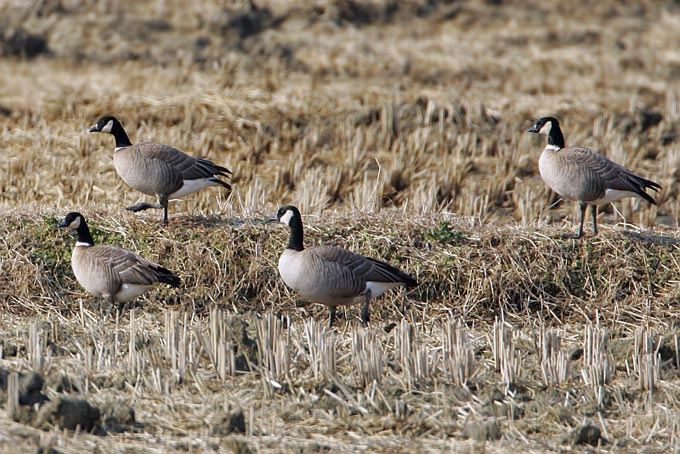
Black Brant Branta bernicla
Away from their regular wintering site at Galsa, Gwangyang Bay, and to a lesser extent along the East coast, there were several atypical inland records in 2007: One was at Junam on January 25th (PJH); one was present at an inland reservoir at Pocheon from November 12th (LSI) to at least November 22nd (PHS); and one was in rice-fields at Seosan from December 2nd to December 7th (KSH).
Whooper Swan Cygnus cygnus
A locally numerous winter visitor. In 2007 an individual ringed in Khabarovsk, Russia in 2004 was seen in the ROK (via KWBS).
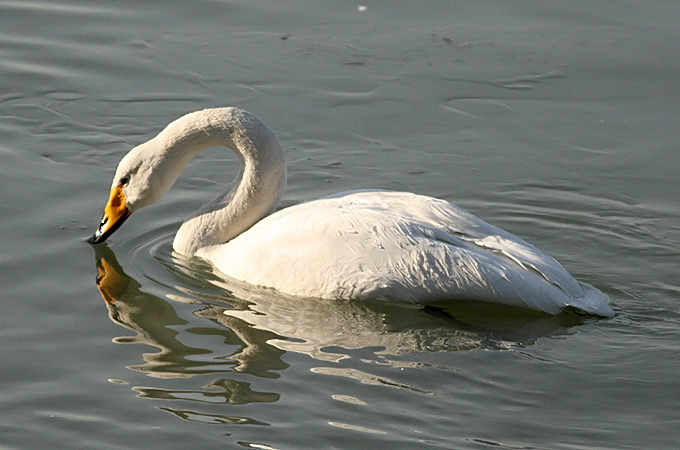
American Wigeon Anas americana
First documented record in 1993 (Park 2002). Probably annual in very small numbers, but status confused by comparatively numerous hybrids.
An adult male (first noted at the Nakdong Estuary, Busan, on December 3rd 2006) was present until at least February 9th (UYJ). A second male was observed at Pohang on October 20th (BHK) and still present on November 26th. In addition, a presumed hybrid American x Eurasian Wigeon A. penelope was photographed at Chungju on November 2nd and posted to BDB.
Baikal Teal Anas formosa VULNERABLE
Now South Korea's most numerous wintering duck, with individuals occasionally over-summering.
On January 11th, 420,000 were counted at the Geum (NM, AW, BIH, PJ, KC, ME, MF), and 2000 were seen at Junam on January 13th (NM, AW, BIH, PJ, KC, ME, MF).
In the second half of the year, 30,000 had returned to Seosan by September 24th (KSH). On September 29th, 1200 were noted at Hwaje, Gunsan (NM, TE, PN). In October, 45,000 were within the Saemangeum reclamation area on the 12th (NM, JYG, YSH), and 300,000 were counted at the same site on the 16th (NM, JYK, DAS, RUS, REL,YSH). The largest count of the year was of 500,000 at the Geum Estuary on December 30th (NM, SHI, NY, KF,KT).
Green-winged Teal Anas carolinensis
In 2007, Birds Korea received an image of a male “digi-scoped” at Daejeon on January 13th, 1979 (WS). This is the first confirmed record of this species in the ROK. There are two subsequent records for the Korean peninsula: singles on the Taedong River, DPRK, in January 2003 and again in February 2004 (Duckworth, 2004).
Red-crested Pochard Netta rufina
A rare winter visitor. In 2007, an adult male was photographed on January 1st at Song Do, Incheon (TE, DS, PH). A second male was at Oksu, on the Han River in Seoul, from March 1st (KSH) until at least March 12th (RN), constituting perhaps the 12th national record.
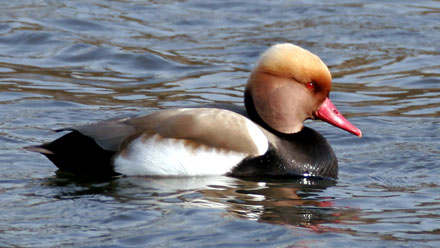
Ferruginous Duck Aythya nyroca NEAR THREATENED
An adult male first noted at Paldang on December 28th 2006, remained on site until at least January 7th (KSH). This is the fourth national record.
Identification of pure individuals is complicated by the relative abundance of hybrids. At least four Ferruginous-type hybrids were recorded in 2007: one presumed nyroca x ferina was present on the Han River at Oksu from January 14th until March 17th (RN); one nyroca x baeri was discovered at the same location on March 3rd (PHW), remaining until at least March 12th (RN); another was seen at Junam on December 8th (NM, TUS); and a presumed nyroca x fuligula was photographed in Gwangju, on November 25th (BDB).
Common Goldeneye Bucephala clangula
A common winter visitor.
A gathering of at least 800 on the Han River at Paldang, Seoul on January 7th (TE, RN) is noteworthy.
Scaly-sided Merganser Mergus squamatus ENDANGERED
The global population has recently been estimated at only 1,000-2500 individuals, and declining (Wetlands International, 2006). This is a typically very wary winter visitor favoring broad (50-100m wide), shallow rivers with areas of faster-flowing, open water. Probably between 20 and 50 winter most years in South Korea (e.g. Moores, 2002), with an additional 40 found on one stretch of river in central Korea (DPRK) in a recent autumn (Duckworth and Kim, 2005).
Records in 2007 came from four sites. At the "North-east River" in Gangwon province (a traditional wintering area), noteworthy counts include ten (4 males and 6 females) on February 2nd (NM, GR, NK, HJ, HM, CJ). A male with a deformed bill, first photographed on January 30th 2005 at the same location, was seen once more on March 10th (NM, MK). In the second part of the year, 15 were noted on November 8th, including the same individual with the deformed bill (CSK).
At Yanngu, Gangwon province, three or four were photographed on March 31st (BH).
On the "South-east River" in Gyeonsangnam Province, three (two males & one female), were noted on January 6th (NM, ST, SH, IT), and four were present from at least December 8th (NM,TUS) to December 30th (NM, SHI, NY, KF, KT).
At Daejeon, a male accompanied by two females was observed on December 30th (RL, HW).
Streaked Shearwater Calonectris leucomelas
A common summer visitor, breeding on a few offshore islands.
Sample counts for 2007 include 78 in one hour between Donghae port and Ulleung Island on June 13th (TE), while 301 were logged between Incheon and Socheong Island on August 20th (NM, DB). One very late record was of a bird found moribund on Eocheong Island on November 8th (NM, TP).
Short-tailed Shearwater Puffinus tenuirostrisAn uncommon migrant from April to October.
The only record in 2007 appears to be of one on June 12th, between Sokcho and Ulleung island (TE).
Flesh-footed Shearwater Puffinus carneipesAn uncommon migrant, most frequent in summer and autumn.
In 2007 one was seen between Incheon and Socheong Island on September 25th (TE), followed by another in the same area on October 12th (RN).
Great Crested Grebe Podiceps cristatus
A common winter visitor, with occasional breeding.
Twelve adults, accompanied by four separate broods on June 7th at Wangsong reservoir, Uiwang, Seoul (TE) is a notable record.
Black Stork Ciconia nigra
Rare in East Asia, with a flyway population of less than 500 individuals (Wetlands International, 2006).
In 2007, three (two adults and a juvenile) were again found wintering at Hampyeong on February 11th (SKS), February 20th (GCS), and February 23rd (LJM). On March 8th one was at Suncheon Bay (KIC), and another was photographed on the rather late date of May 12th, on Socheong Island (NM).
Oriental Stork Ciconia boyciana ENDANGERED
Formerly bred in Korea, presently a rare and localised winter visitor from late October to March. According to survey work and interviews in 2008, several over-wintering birds are perhaps known to local people on offshore islands.
In 2007 recorded from at least six different locations (with no information yet received from Haenam, in most years a key area for the species):
- Seosan reclamation lakes (currently undergoing extensive development): four were present from January 12th (JJJ) and through the month, rising to five on January 28th (JJJ).This number had risen to ten individuals by February 26th (JJJ). Numbers declined steadily until March 12th, when no birds were recorded, perhaps due to the commencement of construction work at their preferred site (NM). In the latter half of the year, only one or two individuals were recorded using this area, e.g. two on November 11th (KSH) and one on December 15th (JSS).
- Jeju Island: one individual (firstnoted in December 2006) was seen frequently until at least August (JYC), perhaps only the second recent national record of over-summering. The same or a different individual was seen again on October 25th (KHM), and intermittently until at least December 29th (BIJ).
- Janghang: Three were seen flying north at Gunsan on February 4th (NM, GR, NK, HJ, HM, CJ).
- Gomso Bay: four on January 4th represents a new site for this species, where also there were four on January 5th, ten on January 10th, and seven on January 16th (all records JYG).
- Within the Saemangeum reclamation area: One was noted on October 22nd (JYG), another on November 8th (NM, TP) and 12th, four on November 17th (PN, AN), and two on November 24th (PJN, AN, RN).
- One was photographed at close range on Baengnyeong Island on December 10th (RN, KDHY)
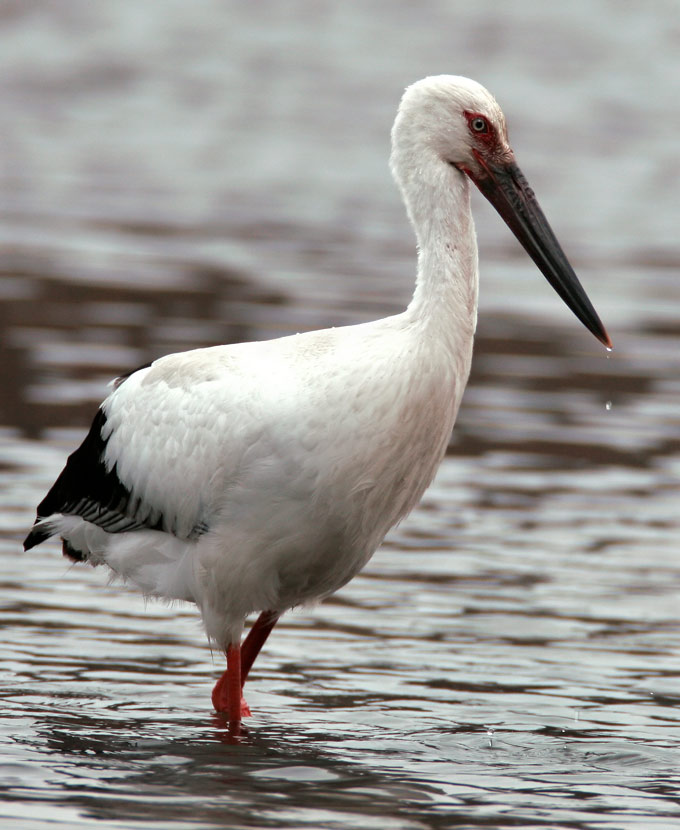
Black-faced Spoonbill Platalea minor ENDANGERED
A local summer visitor, nesting on uninhabited islands in the Yellow sea, and a scarce winter visitor, almost exclusively in the east of Jeju Island.
Unusual counts in 2007 included 50 on Jeju Island on April 3rd (BIJ). At Beka Island in the West Sea, 120 were counted at a nesting colony (PHW) on May 25th. On Yeongjong Island, 25 were present on June 5th (NM, DK). 58 at Song Do, Incheon, on August 21st (NM, DB) is the highest count to date at this highly threatened site, and represents >3% of the world population.
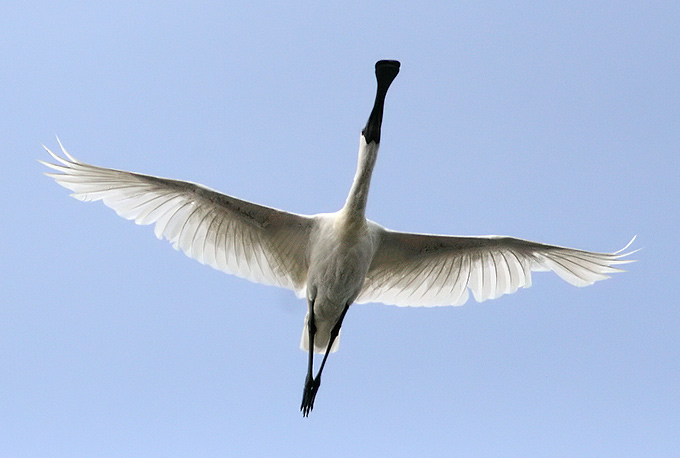
Schrenck's Bittern Ixobrychus eurhythmus
A shy and scarce breeding summer visitor to less-disturbed, heavily-vegetated wetlands, threatened at such sites by vegetation removal and increasing disturbance from road traffic and especially recreational fishing activities.
The species’ vocalizations and displays appear to be poorly described in the (easily-accessible) literature. At a reservoir in Cheorwon, Gangwon Province, on May 31st, a male was watched giving a low, resonant booming - reminiscent of a soft-sounding Great Bittern Botaurus stellaris - while standing fairly obviously at the edge of the reeds. On closer approach, it flew up, closely followed by a female, and then performed an erratic, chasing flight (TE). At the same reservoir on June 5th (when 5 individuals were counted, a similar call was heard and found to be emanating from two males, which then performed a display flight with a female (NM, DK).
Other notable records include one male at Wangsong Reservoir, Uiwang, Gyeonggi Province on June 7th, perhaps the first known record for this recently-restored site (TE).
Cinnamon Bittern Ixobrychus cinnamomeus
One male seen on Socheong Island on May 27th (NM) was quickly followed by another adult male photographed on Hong Island the next day (KSH, CJY).
Although more records exist, Birds Korea knows the details of only four previous records: one on Jeju (collected, May 20, 1983); one in Jinhae, Gyeongsangnam Province (sight record, September 11, 1989); one on Hong Island (sight record: May 31-June 2, 1999); and two on Heuksan Island, May 22nd 2004. According to local observers, the species has also been recorded on Jeju Island, at Hadori, in past years.

Photo © National Parks Migratory Bird Centre, Hong Island
Black Bittern Dupetor flavicollis
A rare spring migrant, first recorded in 1990, with further records at least in 2000, 2003, 2004, 2005, and 2006.
In 2007, two were seen on Eocheong Island on May 25th (DR), while one was flushed at close range on Socheong Island the following morning (RN). This constitutes the first multiple arrival, and probably about the 8th and 9th national records of this species.
Japanese Night Heron Gorsachius goisagi ENDANGERED
A rare migrant through South Korea. Previous records consist of nine specimens (most recently "collected" in 2001), five published sightings prior to 2002, and four records from offshore islands in April/May 2004.
In 2007, one adult was well-photographed (KHM) on Jeju Island between at least October 4th and 16th.
Chinese Pond Heron Ardeola bacchus
Apparently first recorded only in 1988, but now increasingly regular, especially on northward migration, and also as a very scarce breeding species. There are few mid-winter records.
In 2007, one was at Junam Reservoir on January 6th (BHK) and another was in Jeonju City from February 11th to 25th (SKS).
Great Frigatebird Fregata minor
On August 22nd, a presumed juvenile was photographed on Kapa Island, Jeju (KBS). In the opinion of Frigatebird expert David James, this individual was very probably a Great, although on the single image provided it is hard to completely rule out the much less likely Christmas Island Frigatebird F. andrewsi. Great Frigatebird has been recorded once before in Korea (on Jeju, in August 2004).
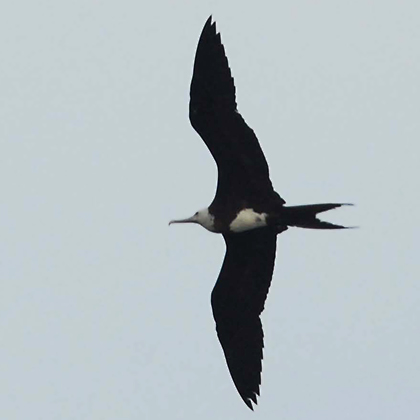
at Gapa Island, South of Jeju. August 22, 2007, Photo © Kim Byung-Su
Lesser Frigatebird Fregata ariel
One photographed at Hadori, Jeju Island on August 15th (JSB) was followed by another seen on Socheong Island the next day (NM,DB).
While there have been multiple claims and sightings in recent years, there are only six documented records pre-2002 according to Park (2002) and two other records since with supporting details known to Birds Korea (in August and October 2004).
Dalmatian Pelican Pelecanus crispus VULNERABLE / Great White Pelican Pelecanus onocrotalus
In 2007, four pelicans of unknown provenance were sighted, from a moving car, below Yeongjong bridge, Incheon, on June 26th (RP, AVDB).
The most recent estimate of the East Asian population of Dalmatian Pelican is put at only 50 individuals (Wetlands International, 2006). Two records of this species are given by Park (2002) for South Korea: one collected in Incheon on November 13th, 1913 (based on Austin, 1948), and the second collected in 1978 (no month given) on Gapa Island, off Jeju. However, a recently published photograph of this mounted Jeju specimen (p. 148. anon, 2008) is not a Dalmatian but is correctly labeled as a Great White Pelican Pelecanus onocrotalus, a species presently not included on the Birds Korea Checklist. While Great White Pelican might seem an extremely unlikely naturally-occurring vagrant, Brazil (1991) states that it has been recorded as an accidental to Japan, with the first record in the southern Nansei Shoto on 26th March 1979. Escapes also occur in Japan, however, including two free-flying birds in Kyushu in the mid-1990s. Following further consideration, Great White Pelican will therefore be added to either Category 1 or 4 of the Birds Korea Checklist, and Dalmatian Pelican will remain in Category 2, with only one historical record (Incheon, 1913).
Amur Falcon Falco amurensis
A scarce migrant. One female at Incheon on June 26th (RP, AVDB) is perhaps the ROK’s first June record. This species is suspected of breeding in the DPRK.
Saker Falcon Falco cherrug
2007 yielded the probably ninth Korean record of this species. One possible was seen at Simpo (Saemangeum) on October 13th (NM, CZ, MIC), and one different individual was then photographed, also within the Saemangeum reclamation area, on November 16th and 17th (NM, JYG,YSH, LN, DAS, RUS, REL, PN, AN). Only four records are listed in Park (2002), though this review omitted at least three further records (one collected in December 1951 [Prentice, 1952]; one seen in Haenam on February 12th 2000, and another on Gago Island on May 9th 2000 by NM). There is also at least one further recent record (one seen by KHT at Seosan, apparently in 2003), and one photograph of a bird (undated) misidentified as Peregrine Falcon F. peregrinus, contained in a Ministry of Environment publication from the 1990s.
Black Kite Milvus migrans
A locally common resident and winter visitor in the southeast, and a regular migrant in small numbers, especially along the west coast.
Notable in 2007 were at least 10 on December 10th on Baengnyong Island. (RN, KDHY).
Steller's Sea Eagle Haliaeetus pelagicus VULNERABLE
A regular winter visitor in small numbers to a few traditional sites.
At the Nakdong Estuary, Busan, one immature was noted on January 7th (NM, ST, SH, IT). In December, one adult was present on the 8th (NM, TUS) and again on the 22nd (RL, HW). On the Han River near Namyangju, three adults were seen on January 7th, and were still present on January 14th (TE, RN). On February 2nd, two adults were noted (NM, GR, NK, HJ, HM, CJ) and a single adult was still at this site on March 1st (NM, MC). Elsewhere, one immature was at Yangyang, Gangwon Province, on February 11th (NM, GR, NK, HJ, HM, CJ).
Himalayan Vulture Gyps himalayensis
A very pale “Griffon-type vulture” was seen at long range, but not identified, near Jinju on February 5th (NM, GR, NK, HJ, HM, CJ). This was then photographed at the same site at close range by multiple observers on February 11th (JJJ), and correctly identified as a First-winter/Second calendar-year Himalayan Griffon Vulture: the first record for Korea. It has been added to Category 1 of the Birds Korea checklist.

An estimated 1000 or 1200 have been present in recent winters (e.g. Lee et al., 2004). In 2007, at least six birds were seen with individually-numbered wing-tags:
- No.30, Jinju, January 7th (SKS). This was later confirmed as having been wing-tagged at Ikh Nart Nature Reserve, Dornogobi , Mongolia, on 21st July, 2006, by a joint US-Mongolian expedition.
- No.17 (Black on white) Cheorwon, January 28th (PHW)
- No.09, Cheorwon, February 1st (NM, GR, NK, HJ, HM, CJ).
- No. 19 (Black on white), Jinju, February 15th (KHT).
- No. 8, near Jinju on November 24th (RL, HW),
- No. 60, present with ca. 120 other individuals, Jinju, December 31st (NM, SHI, NY, KF, KT).

Eastern Marsh Harrier Circus spilonotus
On October 12th a presumed Western C. Aeruginosus x Eastern Marsh Harrier hybrid was seen and photographed over Socheong Island (TE, RN). This individual showed an extensive dark eye-stripe (that nevertheless petered out before the bill base) as well as extensive pale on the underwing primaries. Several “Marsh Harriers” showing mixed features of both species have been observed in Korea previously- notably in October 2000, September 2003, and September 2004, and mixed pairs have been reported in Russia.
Upland Buzzard Buteo hemilasius
In the latter half of 2007, relatively numerous records in comparison to previous winters, e.g. at least six and possibly as many as ten individuals on Baengnyeong Island on December 9th & 10th (RN, KDHY).
Rough-legged Buzzard Buteo lagopus
A typically scarce winter visitor.
In the latter part of 2007, however, relatively numerous and widespread from October onwards, with tens of individuals reported.
Greater Spotted Eagle Aquila clanga VULNERABLE
2007 produced several records of this scarce winter visitor and migrant, with one or two long-staying birds on Jeju, and a scattering of other observations along the west coast, including an immature at Seosan on January 13th & 23rd (KJH) and again on February 2nd (KHT). In the second half of the year, a juvenile was seen on Socheong Island on October 15th (TE, RN), while another was photographed at Saemangeum on the same date (CSH). Two photographed (location unknown) on October 18th were posted to BDB. Finally on December 5th, one was at Bomun Lake, Gyeongju (MC).
Steppe Eagle Aquila nipalensis
A presumed Third calendar-year, first seen in Jinju, Gyeongsangnam Province on January 6th (NM, ST, SH, IT), was present at the same site until at least February 27th (TE, NM). There seems little doubt that this is the same individual seen at the same Jinju slaughterhouse in 2005, becoming approximately the 6th record for the Korean peninsula, and the fifth record for the ROK.

Eastern Imperial Eagle Aquilaheliaca VULNERABLE
One juvenile was reported on Jeju Island for much of December (JH), and well photographed on e.g. December 14th (PBW).
Bonelli's Eagle Aquila fasciata
One Third calendar-year female, found freshly dead by local people on Ui Island, Shinan-gun, on March 21st, and identified by PJG, is Korea’s first record. The species has been added to Category 1 of the Birds Korea checklist.
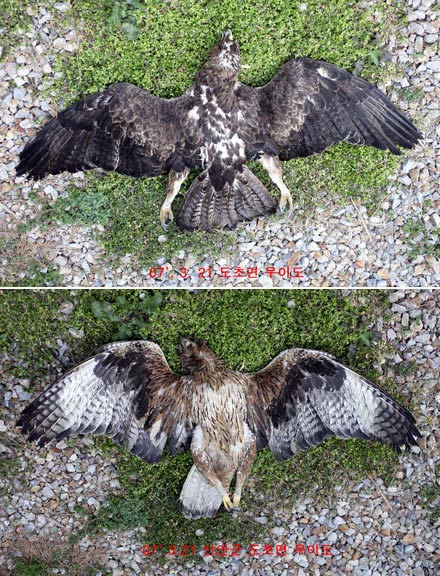
Booted Eagle Hieraaetus pennatus
One pale-phase bird photographed in Gunsan on March 30th (PN) becomes Korea's second documented record, after the first in October 2006. A previous sight record of another pale-phase individual (Socheong Island, on October 20th, 2005) was unsupported by photographs. This species has apparently also been reported from eastern China several times in recent years.
Band-bellied Crake Porzana paykullii NEAR THREATENED
In May on Socheong Island, one was glimpsed on the 18th (NM, ST, KK), followed by an adult seen well on the 20th (KK, HK, TL, JL, STZ, JRK), and another adult seen well in flight on the 22nd (NM). There are only eight previous records (most recently in 2004).
Coot Fulica atra
A locally abundant winter visitor,and local breeding species.
At least 300 on the Han River at Namyangju on January 14th (TE, RN), and over 600 at Yongjeong Island on November 15th (TE) are both rather high counts for Seoul/Incheon. 15 adults with at least three broods of young at Wangsong Reservoir, Uiwang on June 7th (TE) is also noteworthy.
Sandhill Crane Grus canadensis
Although this species occurs annually at Izumi in Japan (after having undoubtedly migrated through the Korean peninsula), there are only between five and six previous records, most recently in 2005 and 2006.
In 2007, one was at Cheorwon on January 8th (JYJ) where it remained and was well-photographed until at least March 21st (KSH).
Common Crane Grus grus
A scarce migrant, with occasional singles wintering, most especially at Suncheon Bay, Jeollanam Province, where probably annual in recent years. Status confused by presence of hybrids with Hooded Crane G. monacha.
In 2007 one Common Crane was at Cheorwon on January 8th. (JYJ), followed by another at Seosan on February 28th (NM, MC). Two were present at this site from March 3rd (TE, RN, GS) until at least March 23rd (KSH). In the latter half of the year, one was again at Cheorwon on October 25th (UYJ), where it remained until at least November 17th (WIK). At Suncheon Bay, two were present on November 3rd (RL) and seen again on December 9th (RL, HW).
In addition, several first or second generation Common x Hooded Crane hybrids were recorded, often accompanying "pure" individuals: these included one at Suncheon Bay on February 5th (NM, GR, NK, HJ, HM, CJ), and three on November 3rd (BDB); two at Seosan on March 3rd (TE,RN,GS); and one second or third generation hybrid at Cheorwon on March 18th (KDW).
Hooded Crane Grus monacha VULNERABLE
A recent estimate suggests a world population of 10,160 with 8,700 wintering in Japan (presumably after migrating through Korea), and a much smaller number in the ROK (Wetlands International, 2006). Counts away from the usual sites (Suncheon Bay and Gumi) included at least 70 on Jeju Island on March 19th (BIJ), and 160 at Seosan Lake A on November 16th (NM, JYK, DAS, RUS, REL, YSH, LN, KISK, KHT, KSH).
Yellow-legged Buttonquail Turnix tanki
A rather scarce and very skulking migrant.
The only record for 2007 known to Birds Korea was from Socheong Island, where one was flushed from long grass on October 14th (TE).
Eastern Oystercatcher Haematopus (ostralegus) osculans
The largest count in 2007 was of 2240 at Yubu Island, Geum Estuary on August 16th (NM, JYG). At the highly threatened site of Song Do, Incheon, 108 were counted on August 20th (NM, DB). Otherwise noteworthy was one aberrant individual photographed on Yubu Island on September 28th (TE), which had a rather down-curved bill and a faint white neck collar.
Black-winged Stilt Himantopus himantopus
One at Gwangju, on or around December 16th (BDB), and another at Upo Ramsar site (e.g. on January 28th: NM, GS, ES) are perhaps only the second and third midwinter records on the mainland.
Pied Avocet Recurvirostra avosetta
A rather rare migrant, now recorded annually, most often in autumn, and very occasionally in winter.
2007 was a good year for this species, being reported from five locations, and with records involving at least seven individuals.
In March, one was at Seosan between March 30th (PMJ) and April 4th (KIG), while there was another at the Mokpo Namhang Urban Wetland from March 28th until April 13th (KSY). On April 21st, one was at seen Haje, Saemangeum (PN, JM), and another was on the Namdae Stream, Gangneung, on May 5th (PJY).
In November, one was found at Song Do, Incheon on 12th (BDB), remaining there until April 2008, with another found on Jeju Island on or around November 21st (BDB), with three together there by December 29th (BIJ).
Grey-headed Lapwing Vanellus cinereus
A very scarce migrant, with several records annually (largely concentrated on western islands, at Seosan and on the east coast).
The only record of the year known to Birds Korea was of two at Yanngu, Gangwon Province, on May 25th (BH).
American Golden Plover Pluvialis dominica
A fully breeding-plumaged adult was seen at Okgu, Saemangeum May 17th, by a very experienced shorebird specialist (DR) during SSMP fieldwork. No photographs were taken and the structure of the bird was not well-noted. However, identification was made very confidently by the observer, and a full description has been received. This is the first claim for the ROK, and the species has been added to Category 3 of the Birds Korea Checklist
Common Ringed Plover Charadrius hiaticula
A rather rare but increasingly observed migrant.
2007 proved rather exceptional for this species. In spring, an adult male at the Geum Estuary on March 31st (PN) was perhaps the same individual seen at the same site on April 14th (NM, PJG, PDH). One First-winter type was at Namdang-ri on April 2nd (KSH), followed by one at Gunsan on April 6th (GS, TD). At the Geum Estuary, one was noted on April 14th and 18th (SSMP). In the autumn, one was photographed at Namdang-ri on August 15th and at Hongseung on August 23rd (KSH)., followed by two photographed together at the Nakdong Estuary on September 19th (NM, JVDK, JL, JSJ).

Kentish Plover Charadrius alexandrinus
A common passage migrant, local breeder, and scarce winter resident. 3080 at Yubu Island on October 14th (NM, JYG, TTV) is the year’s largest count of this species.
Greater Sand Plover Charadrius leschenaultii
At least 35 were present at Yubu Island in the Geum Estuary on August 17th (NM, DB, JYG), constituting perhaps the largest yet known concentration of this species known to Birds Korea.
Oriental Plover Charadrius veredus
A very scarce migrant, apparently annual in the far southwest.
An adult, moving from breeding into non-breeding plumage, was seen at Yubu Island, Geum Estuary, on August 16th (NM).
Greater Painted Snipe Rostratula benghalensis
A scarce and largely overlooked species, with small numbers breeding, occurring on migration and also over-wintering.
In 2007 one was photographed at Seosan on January 27th (JJM). On Jeju Island, one was seen on May 27th (JBG), and breeding was then confirmed and photographed on June 20th (KHM): perhaps only the third formal documentation of breeding since the first and second records at Seosan and near Busan in 2006.
Pheasant-tailed Jacana Hydrophasianus chirurgus
First recorded in 1993 (Park, 2002), and now reported annually, especially in summer, breeding for the first time on Jeju Island in 2006.
In 2007, one was photographed at Seosan on June 10th (KHK), and again at the same location on November 2nd (JSS). At Upo Ramsar site, breeding was confirmed on August 1st (HSY), when two chicks were hatched, but apparently failed to fledge. At Junam Reservoir, two were in territory in mid-July and breeding was confirmed on August 26th (KJH). By September, four chicks had been successfully raised. Breeding at one further site has also been filmed in Jeollanam Province.
Solitary Snipe Gallinago solitaria
A rare and extremely localised winter visitor from November to March, with a non-breeding population estimate of only 10 (Moores, 2006).
Away from the regular wintering site at the National Arboretum, one was seen at Namyangju on January 15th (KDH).
Long-billed Dowitcher Limnodromus scolopaceus
A very scarce migrant first recorded in 1998 (Moores, 1999), and now recorded annually.
One was photographed at Seosan on November 11th and 12th (CHS).
Black-tailed Godwit Limosa limosa NEAR THREATENED
A locally common passage migrant, mostly along the west coast northward from Seosan. At Song Do, Incheon, a count of 7950 on August 20th (NM, DB) represents almost 5% of the estimated flyway population.
Eurasian Whimbrel Numenius phaeopus
One at the Geum Estuary on February 4th (NM, GR, NK, HJ, HM, CJ) is only approximately the fourth record of over-wintering known to Birds Korea.
Far Eastern Curlew Numenius madagascariensis
Mid-winter records include two at Song Do on January 16th (NM, AW, BIH, PJ, KC, ME, MF) and probably the same two again seen on January 31st (NM,GR, NK, HJ, HM, CJ). Additionally, one was seen at Guryongpo on December 7th (NM, TUS).
Common Redshank Tringa totanus
An uncommon migrant, with an estimated 100 present on northward migration and 250 on southward migration (Moores, 2006), recently proven to breed in very small numbers. One at Suncheon Bay on January 12th (NM, AW, BIH, PJ, KC, ME, MF) is a rare winter record. At Yeongjong Island on May 16th, at least three were seen displaying (NM, KK, HK, TL, JL, STZ, JRK), with two exhibiting territorial behaviour at the same site on June 5th (NM).
Nordmann's Greenshank Tringa guttifer ENDANGERED
Globally, this species has an estimated population of between only 500 and 1000 individuals (Wetlands International, 2006). A scarce and local migrant (very much overlooked as largely confined to extensive estuarine tidal-flats), with a national estimate of 100 on northward and 150 on southward migration (Moores, 2006).
In 2007, most counts were made during the Saemangeum Shorebird Monitoring Program (SSMP) and are therefore published in Moores et al. (2007). In spring, evidence of northward migration began with nine at Yubu Island, Geum Estuary on April 15th (NM, PJG,AP), followed by 16 in the Geum Estuary on April 18th and 15 on April 24th (SSMP). Also in April, one was at Hwaseong (outer Namyang Bay), Gyeonggi Province, on April 17th (SKS), increasing to five by May 5th (SKS). At least nine were within the Saemangeum reclamation area during May (SSMP), and a further 51 were counted at Yubu Island, Geum Estuary, during the mid-May count cycle (SSMP). Two were also at Yeongjeong Island, Incheon, on May 17th (NM, KK, HK, TL, JL, STZ, JRK).
On southward migration, two were noted at Song Do, Incheon on August 21st (NM, DB). On September 12th, there were two at the Mangyeung Estuary (Saemangeum) and four on Yubu Island (NM, JYG, JVDK, JAL), increasing to 13 there on September 28th (TE, JYG, NM, KSH), with 15 present at Saemangeum the following day (TE, NM, PN).
Also in September, one was photographed at close range in the Nakdong Estuary on September 22nd (JYG, KIBS, JSJ). On October 12th, two were in the Saemangeum reclamation area (NM, JYG, YSH), and on October 14th between 46 and 50 were counted at Yubu Island (NM, JYG, TTV).
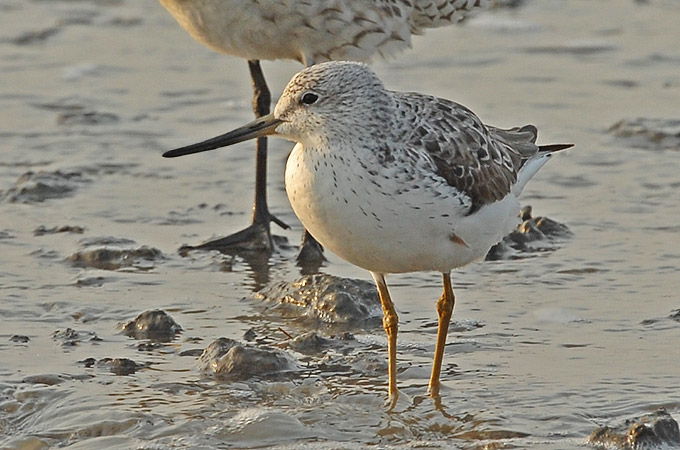
Red Knot Calidris canutus
One at Saemangeum on November 16th (NM, JYK, DAS, RUS, REL, YSH, LN) is a very late date.
Great Knot Calidris tenuirostris
230 at Saemangeum on November 7th (NM, TP), is an exceptional count for so late in the season.
Sanderling Calidris alba
A count of 590 at Yubu Island on August 16th (NM, JYG) is noteworthy.
Little Stint Calidris minuta
A very scarce migrant, first claimed in 1996 (Park, 2002), and with only c. 10 records subsequently. Recorded annually since 2002.
One juvenile was seen but not photographed at the Nakdong Estuary on September 20th (NM).
Pectoral Sandpiper Calidris melanotos
A rare migrant, with usually only one or two records per year.
In 2007 one was photographed within the Saemangeum reclamation area on October 12th (NM, JYG, YSH).
Dunlin Calidris alpina
A locally numerous migrant and winter visitor.
A bird photographed in Saemangeum on October 6th (JYG) was later confirmed as having been banded in Barrow Alaska, on June 24th 2004 - where it successfully nested in both 2004 and 2005.
Spoon-billed Sandpiper Calidris pygmea CRITICALLY ENDANGERED
Very fast-declining, with a minimum world population estimate in 2006 of less than 3,000 individuals (Wetlands International, 2006), and in 2008 of possibly fewer than 300 pairs.
In 2007, extensive coverage by the Saemangeum Shorebird Monitoring Program (SSMP) showed that the Geum and Mangyeung Estuaries remain vitally important staging areas, and that the much-degraded Saemangeum tidal-flats can only continue to support the species as long as the (now limited) daily tidal flow is maintained or increased (Moores et al., 2007). Further, surveys by several different organisations (included in unpublished and published data) in the Nakdong Estuary demonstrate that site also supports the species annually, in small numbers (probably fewer than fiver per year).
In 2007, records of northward migration commenced with one at Gunsan on April 22nd (JM,PN), followed by two at Okgu on April 24th and one more at the same site on April 27th (both records SSMP). In May, five were on Yubu Island on the 15th (SSMP), with a total of eight identified there during northward migration. Four were present on May 23rd at Simpo, Saemangeum (NM, TB), followed by a count of 31 at the same site on May 26th (GS, TD). During southward migration, two or three were found at Yubu Island on August 16th (NM, JYG), where three were also seen the following day (NM, DB, JYG). The same site held 13 individuals (including five juveniles) on September 12th (NM, JYG, JVDK, JAL). At the Nakdong Estuary, three juveniles and one possible adult were present on September 19th & 20th (NM, JVDK, JL, JSJ, KIBS), with two juveniles still present on September 22nd (JYG, KIBS, JSJ).
Back on Yubu Island, 11 were seen on September 28th (NM, TE, KSH, JYG). In October, one was at Simpo, Saemangeum, on the 5th (JYG) with 11 still at Yubu Island on the 14th (NM, JYG, TTV).
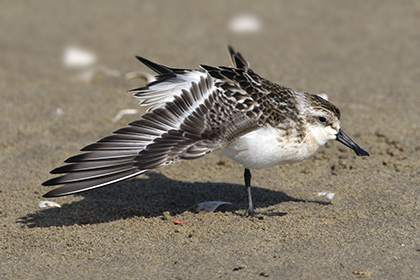
Broad-billed Sandpiper Limicola falcinellus
Notable counts included 750 at Yubu Island on September 28th (NM, TE, JYG, KSH) and 1251 within the Saemangeum reclamation area on October 12th (NM, JYG, YSH).
Buff-breasted Sandpiper Tryngites subruficollis
One photographed on September 2nd at the Nakdong Estuary (PCR) is the first acceptable record of this species in Korea, and it has been added to Category 1 of the Birds Korea checklist. Although Buff-breasted Sandpiper is already listed both by Lee et al. 2000 and Park (2002) (apparently based on a record of one collected on April 27, 1972 in Shiheung and published by Fennell, presumably the same year), the same author actually died in January 1972, three months before the record, indicating an error in either the date or documentation.
Red Phalarope Phalaropus fulicaria
One was seen well from the ferry between Eocheong Island and Gunsan City on November 8th (TP, NM.). There are possibly less than 10 national records.
Black-tailed Gull Larus crassirostris
A locally numerous breeding species, and winter visitor (when most numerous along the east and south coasts). At the Geum Estuary between August 17th and 20th, at least 5000 were found dead due to a suspected outbreak of avian botulism.
Glaucous Gull Larus hyperboreus
One adult and one first winter at Song Do, Incheon on January 15th (NM, AW, BIH, PJ, KC, ME, MF) represents an unusual record for Incheon/Geyonggi. While most Korean records refer to pallidissimus, a sub-adult and a First-winter barrovianus were photographed at Guryongpo on February 9th (NM, GR, NK, HJ, HM, CJ).
Iceland Gull Larus glaucoides
An apparent juvenile/first winter Kumlein's Gull Larus glaucoides kumleini was seen on the Guryongpo Peninsula on November 6th (NM, TP). Iceland Gull is claimed almost annually in Korea, with most individuals apparently being close to nominate glaucoides in appearance.
Mongolian Gull Larus mongolicus
One wing-tagged individual, "AB48", was photographed on November 11th at Hongseung (KHT).
Caspian Gull Larus cachinnans
One adult possible/presumed “eastern type” cachinnans was photographed at Hupo, Gyeonsangbuk Province, on February 10th (NM, GR, HM & CJ) although identification remains tentative. Another adult, also considered to be an “eastern type”, was seen in the Mangyeung Estuary, Saemangeum, on May 1st (NM). A third "eastern type” (possibly a Fourth-winter) was photographed (PJG) on Heuksan Island on December 15th, with this identification supported by gull expert Andreas Buccheim. While there are now annual claims of this taxon (since 2005), the status of Caspian Gull in Korea remans clouded by a lack of knowledge of the extent of variation in cachinnans and in e.g. Larus heuglini barabensis.

American Herring Gull Larus smithsonianus
Although there have been c. ten recent records in South Korea, criteria for separation from extreme individuals of vegae and birulai (if such a taxon exists) and even intergrades/hybrids between the various taxa are not well-established.
In 2007, one adult was at the Nakdong Estuary on January 13th (NM, AW, BIH, PJ, KC, ME, MF), and another was seen at Guryongpo on February 14th (KMO, FI).
Pallas's Gull Larus ichthyaetus
First recorded in December 2002 and annually since, in winter/early spring.
In 2007 one adult, first noted at Oksu along the Han River in Seoul on December 31st 2006 (PGS) remained until at least March 7th (RN). At Song Do, a First-winter was seen on March 11th (NM, MK): the 11th national record.
Saunders's Gull Larus saundersi VULNERABLE
A very local breeding species, becoming more widespread in winter.
Although extensive tidal-flat reclamation and construction has been continuous at Song Do, 210 were counted on January 31st (NM, GR, NK, HJ, HM, CJ), rising to 317 on March 11th (NM, MK), and with 250 present on April 1st (TE, RN). Due to a general lack of coverage through the summer, the success (or otherwise) of the local breeding colony could not be gauged, and the few visits to the site failed to sight any Saunders's Gull. However, up to 80 present on November 20th (TE) contained at least 30 First-winters. At Yeongjong Island, Incheon, 50 were noted on March 10th (PHW), where the local breeding colony contained between 84 and 95 individuals on May 16th, with many birds sitting. This colony is threatened by extensive building work now surrounding the salt-marsh used by the birds. Not far away at Choji mudflat, Gangwha, 100 were seen on April 2nd (PGS). Further south at the Mangyeung Estuary, Saemangeum, there were c.200 on February 4th, with "several hundred" also present at the Geum Estuary (PN, JM). At nearby Yubu Island, 50 were counted on April 18th (SSMP), and a small colony was discovered on recently reclaimed land in Gunsan (PN): the southernmost breeding record in Korea. The success rate of the colony was not measured, but there was a juvenile with an adult on nearby Yubu Island on August 16th (NM, JYG), suggesting successful local breeding.
Relict Gull Larus relictus VULNERABLE
A recent population estimate puts the world population at 12,000 individuals (Wetlands International, 2006). A scarce winter visitor to ROK, much more numerous in cold than mild winters, and most regular between December and February.
At the Nakdong Estuary, one was at Dadapo on January 6th (PK), followed by one Second-winter and three adults at Song Do on January 15th, with six at the same site the following day (NM, AW, BIH, PJ, KC, ME, MF). One adult was still present there on January 31st (NM, GR, NK, HJ, HM, CJ). In December at the Nakdong Estuary, one First-winter was found on December 8th (NM, TUS), and three were seen on December 22nd (RL, HW). Eight First-winters were present in the same area on December 31st (NM, SHI, NY, KF, KT).
Gull-billed Tern Gelochelidon nilotica
One seen at Gomso Bay on May 1st (AR, NMI, KW, JYK) is apparently only the fourth national record.
Aleutian Tern Sterna aleutica
Category 3. A little-known species,breeding in Eastern Siberia and Alaska.
In 2007, the only record was of one between Incheon and Socheong Island on August 20th (RN). Previous (sight records only) include one moving south with flocks of Common Tern S. hirundo from Igidae, Busan on August 28th 2006: one, 70km E/SE of Socheong Island, on August 23rd 2004, and up to three from Igidae, Busan on September 7th 2005 (all records NM).
Whiskered Tern Chlidonias hybridus
First recorded in 1998, since when it has been a scarce (though increasingly recorded) passage migrant.
In 2007, two first seen on January 3rd at Okgu Reservoir, Gunsan (PN, JM) remained until at least April 23rd (RN).This is presumed to be the first record of successful over-wintering. 30, also at Okgu reservoir, on September 7th (PN) is the highest national count to date, with the last record there in the autumn of one photographed on October 4th (KHG, NPMBC).
White-winged Tern Chlidonias leucopterus
An uncommon migrant, most numerous in autumn.
Approximately 265 at Okgu Reservoir on September 7th (PN) is easily the highest national count of this species to date. A further six at Seosan on October 4th (LHS), seems rather late for such a large count.

Black Tern Chlidonias niger
At least one was photographed (with the possibly of one other present) on September 2nd at Okgu Reservoir, Gunsan (PN, RN), representing only the third record for Korea. Previous records are of one photographed at Seosan in May 2001 and two seen near the Dongjin Estuary, Saemangeum, in August 2005.
Thick-billed Murre Uria lomvia
First recorded in 2006, when two or three records. In 2007, one was off Daebo along the Guryongpo Peninsula, on December 7th (NM), and at least two were photographed in flight (PJG) on December 21st near Beka Island, Soseong Gun, in Gangwon Province.
Common Murre Uria aalge
A very uncommon winter visitor, not recorded annually in recent years.
One was photographed near Beka Island, Gangwon Province on December 21st (PJG).
Spectacled Guillemot Cepphus carbo
Although presumed to breed locally in DPRK, it is a rare winter visitor in the ROK, with the majority of records coming from northernmost Gangwon Province.
In 2007 four were observed (and one was found dead), near Hwajin Po, Gangwon Province, on February 11th (NM,GR,NK,HJ,HM,CJ).
Long-billed MurreletBrachyramphus perdix NEAR-THREATENED
Now recorded annually in very small numbers on the east/south-east coast.
In 2007, one was off Guryongpo on January 14th (NM, AW, BIH, PJ, KC, ME, MF), where also four were present on February 9th (NM, GR, NK, HJ, HM, CJ). At Hwajinpo, Gangwon Province, one was seen on February 11th (NM, GR, NK, HJ, HM, CJ, RN), with further singles at Guryongpo on February 16th (NM, GR, NK, HJ, HM, CJ, RN), and March 10th (NM, MK). An adult moving into breeding plumage between Yeon Island and Eocheong Island on April 21st (NM, GS, SD, CSH, KHK et al.) and a presumed juvenile (in a very black-backed non-breeding plumage), seen between Socheong Island and Incheon on August 20th (NM), appear to be the first records for the Korean part of the Yellow Sea. On December 7th a further one or two were again seen on the east coast, off Guryongpo (NM, TUS).
Least Auklet Aethia pusilla
Two were seen off Hwajinpo on February 11th (NM, GR, NK, HJ, HM, CJ). There are probably still less than five national records.
Red Turtle Dove Streptopelia tranquebarica
One on April 28th on Weiyon Island (LWG) was followed by another photographed on Eocheong Island on May 8th or 9th (TL). These constitute approximately the 10th or 11th records, with all but one of these since 2001.
White-bellied Green Pigeon Treron sieboldii
One on Jeju Island on January 14th (BIJ) is apparently the 11th record for the ROK.
Large Hawk-Cuckoo Hierococcyx sparverioides
One on Socheong Island from May 19th-22nd was very poorly-seen by several observers (NM, KK, HK, TL, JL, STZ, JRK), and sound recordings were made. This is the first record for Korea and the species has been added to Category 1 of the Birds Korea checklist.
Ural Owl Strix uralensis
One photographed at Wonju on February 22nd, was subsequently photographed in the same area, at the nest with young on May 11th (YKH) – apparently the first breeding record for the ROK. One was also photographed in Taebek City, Gangwon Province in May (CSK). Another, from Sangwon-sa forest near Pyeongchang in Gangwon Province, was taken into care on November 14th (NPMBC). The last record of the year was one photographed in a cave at Pyeongchang, on November 17th (HSH).
Little Owl Athene noctua
One at Chungju on January 1st (CSK) was seen again on the 28th (JSS).
On Yeongjong Island, two young were discovered at a construction site and taken into care on May 25th (KDH), constituting the first breeding record of this species in the ROK. One of these chicks was later released at Seosan on October 30th (KWBS/SKS).
At Paju, one was photographed on February 5th (WCU). Presumably the same individual had returned there (to roost in the same bridge) from November 15th (JDM) to December 12th (WCU).
Pacific Swift Apus pacificus
On May 26th, 1500+ were seen heading north from "Northeast Point" on Socheong Island, in only 40 minutes (TE). The movement was already ongoing when first noticed, and likely involved many more birds than were counted. This is the largest day-count of this species known to Bird Korea.
House Swift Apus nipalensis
A rare migrant.
In 2007, two were seen over Socheong Island on August 18th (NM, DB), and one was recorded there on August 21st (RN).
Oriental Dollarbird Eurystomus orientalis
A common breeding summer visitor.
One on Eocheong Island on the late date of October 7th (NM) is considered notable as most have usually migrated by September.
Grey-capped Pygmy Woodpecker Dendrocopos canicapillus
A rather scarce and easily-overlooked species, with a highly enigmatic distribution. On the Korean peninsula it was considered by Austin (1948) to be "a not uncommon summer resident: a few winter in the central and southern provinces", and in the ROK by Gore and Won (1971) as an "uncommon resident in the mountains in summer, in the lowlands in winter". In recent decades it has been reported only rarely and mostly in the winter months, with just two records in the 1990s, both in Gyeonggi Province (Park, 2002). Based on its historical distribution, however, and a recent increase in records (reflecting perhaps both increased observer activity and also re-growth of forests), it seems likely that this species will prove to be a scarce resident in Gyeonggi and perhaps Gangwon Provinces.
In 2007, several records: two found at Ilsan water park, Seoul, on January 28th (KHK) were still present on February 12th (NM, GR, NK, HJ, HM, CJ). On February 17th, one was photographed at Heunguk temple, near Yeosu (WCU): apparently the southernmost record to date. In the latter part of the year, one was at Shiripdae, Seoul on September 28th (RN), and another was seen at the National Arboretum, Gyeongii Province, on November 9th (NM, TP). Finally, one or possibly two were also photographed in Pocheon on December 18th (CSJ).
Fairy Pitta Pitta nympha VULNERABLE
A very scarce and local breeding species, most regular and numerous on Jeju Island.
Two were found dead on Chilbal Island, Shinan County, between June 20th and 26th (RP, AVDB).
Black-winged Cuckooshrike Coracina melaschistos
One male seen perched and briefly in flight on May 22nd on Socheong Island (JL, JRK) is probably about the 5th national record, with no less than three of the previous sight records/claims also from Socheong (Moores, 2007).
Brown Shrike Lanius cristatus
A scarce and declining summer visitor and passage migrant.
On Socheong Island, 70 on May 18th (NM, KK, HK, TL, JL, STZ, JRK) is a noteworthy day count. On July 23rd at Hannam, Seoul, a Brown and Thick-billed/ Tiger Shrike L.tigrinus mixed pair was photographed at the nest (KGW): the second such pairing recorded in Korea.
Long-tailed Shrike Lanius schach
An increasingly recorded species since the first in 1994, with between two and five records annually, mostly in the southwest.
In 2007, one first found at Seosan on October 29th 2006 remained on site until at least March 3rd 2007 (TE, RN, GS). Another was at Muan, Jeollanamdo on January 10th (CSK).
Great Grey Shrike Lanius excubitor
Only five previous records are listed for Korea in Park (2002), all falling between November and February.
One was photographed (KCW) on Jeju Island in January 2007, with the subspecies identified as mollis in Seo & Park (2008).
Black Drongo Dicrurus macrocercus
A scarce but increasingly recorded overshooting migrant, particularly in spring.
Among a scattering of spring records in 2007, two at Taean on May 27th (LHS) were notable mainland records. The highest day-count for the year was of seven on Socheong Island on May 26th (TE, RN).
Ashy Drongo Dicrurus leucophaeus
First recorded in 2001, and thereafter almost annually in spring, and more rarely, in autumn.
In 2007 one was seen briefly in flight at Socheong Island on May 18th (KK, TS, NM), becoming approximately the 8th record for South Korea, and 9th for the Korean peninsula.
Hair-crested Drongo Dicrurus hottentottus
One on Socheong Island on May 21st (RN, NM, TE, KK, HK, TL, JL, STZ, JRK) was seen again the following day (TE). This is approximately the twelfth national record.
Northern House Martin Delichon urbica
First recorded in 2003, and thereafter as a near-annual migrant in April and early May, and again in September.
One seen on Eocheong Island on April 22nd (NM, GS, ES, CSH, KHK) is probably at least the 12th record for South Korea.
Asian House Martin Delichon dasypus
A local but relatively common migrant, particularly to offshore islands, with occasional winter records.
Ten at Taejongdae, Busan on December 4th (KHG), is the largest national midwinter count to date.
Red-rumped Swallow Cecropis daurica
At least 3000 seen migrating over Socheong Island on October 13th (TE, RN) is an exceptionally high day-count for this species.
Long-tailed Tit Aegithalos caudatus
Two subspecies breed on the Korean peninsula, with magnus resident south of the 38th parallel, and white-headed birds, tentatively assigned to caudatus found northward, occasionally irrupting southward in winter in large numbers.
In 2007, one caudatus was found in a flock of magnus at Yanggu, Gangwon province, on the exceptional date of July 29th (BH). On October 12th, c. 300 caudatus were recorded on Gangwha Island (PKS). On October 13th, a flock of 56 caudatus (and four magnus) were at the lighthouse on Socheong Island (TE), with c. 100 counted there the next day (TE, RN), when 10 were also seen in Hyochang Park, Seoul (PHS). Subsequently, 20 were at Paju on October 17th (JDM), and c. 100 at Yeongsan, Seoul on October 25th (PHS). After this initial major arrival, there were numerous and widespread records of white-headed birds through the winter (and into spring 2008). The most southerly record was from Gunsan, where two were seen on December 22nd (PN).

Light-vented Bulbul Pycnonotus sinensis
First recorded in 2002, with the first breeding record in 2004.
In 2007, one at Hong Island, Jeollanam Province on February 28th (PJG) is probably only the second midwinter record nationally. At least one photographed at Beka Island from April 28th - May 1st (SHS) represents a new site for this species.
At Socheong Island, a pair was noted nest-building on May 27th (TE) and two juveniles were noted on August 21st (RN), representing breeding success for the third year in a row. One heard at Eocheong Island on November 7th (NM, TP) is only the second record for the island.
Gray's Grasshopper Warbler Locustella fasciolata
A scarce migrant.
Twenty-six, on May 27th on Socheong Island (NM) is a new national high day-count.
Thick-billed WarblerPhragmaticola aedon
A scarce migrant, more regular northward, especially in late May and again in August and September.
Eighteen on Socheong Island on May 27th (NM) is a new national high day-count.
Black-browed Reed Warbler Acrocephalus bistrigiceps
A fairly common migrant and local summer visitor to the far northeast, with the highest day-count this spring of 60 on Socheong Island on May 27th (NM).

Manchurian Reed Warbler Acrocephalus tangorum VULNERABLE
One photographed on May 20th on Socheong Island (TL), is only the third record for Korea supported by photographs: the two previous involved singles in October 2000 on Gageo Island, and in October 2002 on Socheong Island. In addition, two probables were seen on Hong Island in May 2004.
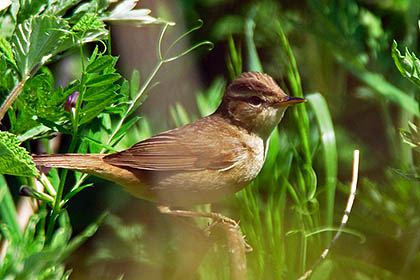
Socheong Island, May 20, 2007, Photo © Thomas Langenberg
Willow Warbler Phylloscopus trochilus
One banded on Hong Island on September 26th is the third record of this species in the ROK, after two were banded there on September 20th, 2006.
In addition, one probable was seen on Eocheong Island on September 30th, with another probable also on October 9th (NM).
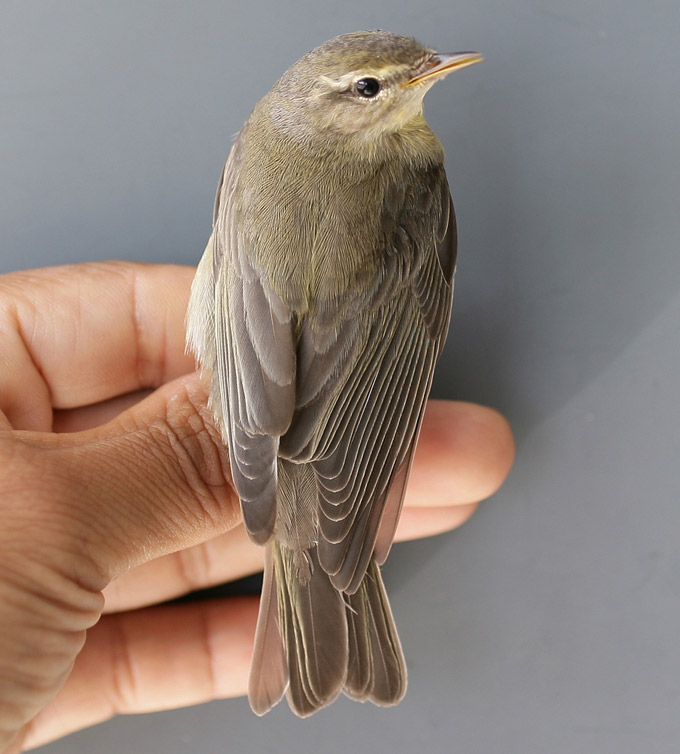
Wood Warbler Phylloscopus sibilatrix
One photographed on Dok Island (Dokdo) in the East Sea on September 13th (KJU) is the first record of this species in Korea, and has been added to Category One of the Birds Korea checklist. This species occurs very rarely in neighbouring Japan, especially on the East Sea island of Hegura.
Common Chiffchaff Phylloscopus collybita
One, well-photographed and seen by multiple observers on Eocheong Island, between at least May 8th (YDH) and May 14th (PJH) appears to be approximately the sixth record for the Korean peninsula.

Dusky Warbler Phylloscopus fuscatus
One or two at Gomso Bay on January 11th (NM, AW, BIH, PJ, KC, ME, MF) is perhaps only the second or third January record, after the first in 2001.
Yellow-streaked Warbler Phylloscopus armandii
One, on May 18th on Socheong Island, was watched clearly though briefly as it called (NM, ST), and heard shortly after (KK & HK). This constitutes the first record for Korea, and as a multiple observer record, it has been added to Category One of the Birds Korea checklist.
Hume's Warbler Phylloscopus humei
First recorded in 2000, and annually since as a scarce (but probably much overlooked) migrant, primarily in late April/early May and again in late October/early November.
In 2007 on Eocheong Island one was present on May 4th (RN), and at least two presumed Hume’s were seen from May 10th-14th in the same area (TE). One possible was photographed between April 28th and May 1st on Beka Island (SHS), and on Socheong Island, one was seen on May 18th (NM, KK, HK, TL, JL, STZ, JRK).
Arctic Warbler Phylloscopus borealis
A common passage migrant, with birds of several subspecies thought to occur. Based on genetic differences, recent research (Saitoh et al., 2006; Reeves et al., 2008) has suggested the need to rearrange the taxonomy of presently described subspecies. Further, Saitoh et al. 2006 “conclude that examinandus and xanthodryas might advisedly be treated as distinct species, because they have been separated from each other and from borealis for a considerable time, probably throughout the Pleistocene”. In their assessment, Arctic Warbler P. borealis breeds largely to the west and also the far northeast of Korea (as includes kennicotti), xanthodryas breeds in Japan, and examinadus breeds in Kamchatka. Based on major differences in songs heard in Korea, it is very likely that at least both borealis and xanthodyas are regular and occasionally numerous in Korea during migration.
Notable spring day counts of 200 Arctic Warbler Sensu lato on May 19th (NM, KK, HK, TL, JL, STZ, JRK) and 189 on May 27th (NM) both were from Socheong Island.
Sakhalin Leaf WarblerPhylloscopus borealoides
A very rarely recorded migrant, on present knowledge perhaps impossible to separate on plumage from Pale-legged Leaf Warbler P. tenellipes.
One on June 4th on Eocheong Island (NM), was tentatively identified on call.
Lesser Whitethroat Sylvia curruca
One found at Miyeonji, Busan on December 29th 2006 (PH, DS) remained until at least January 6th (NM, ST, SH, IT), becoming the fourth record for Korea. Following correspondence with several experienced observers (including Andrew Grieve), the Busan bird was identified as most likely belonging to subspecies halimodendri. Previous Korean records are also from December and January.
Chestnut-flanked White-eye Zosterops erythropleurus
A conservative estimate of 800 were on Socheong Island on May 19th, with flocks watched moving east across the island throughout the morning. This is believed to be a new national high count of the species in the ROK (NM, KK, HK, TL, JL, STZ, JRK).
Eurasian Treecreeper Certhia familiaris
One on November 3rd in Yanngu, Gangwon Province(BH) heralded a winter irruption, unprecedented in recent years, with numerous sightings throughout the north and west, at least as far south as Eocheong Island - where one was recorded, for the first time, on November 7th (NM, TP).
Chestnut-cheeked StarlingSturnus philippensis
A scarce migrant in spring and autumn (with most records between mid-April and early May and again between mid-September and early October) and perhaps extremely local breeder.
On June 6th a hybrid pair involving a male Chestnut-cheeked and a female Purple-backed Starling S. sturninus was photographed at the nest with two young in Hannam, Seoul (KGW).
Red-billed Starling Sturnus sericeus
First recorded in 2000, and thereafter as a regular migrant and scarce over-winterer, mostly along the west coast in spring, along the east coast in autumn and on Jeju Island in winter.
In 2007 a brood was photographed at the nest in Jeju City on July 5th (KHM), becoming Korea's first proven breeding record.
Siberian Thrush Zoothera sibirica
A scarce migrant.
In 2007, a male of the subspecies davisoni was seen well on Socheong Island on May 19th (NM,KK,HK,TL,JL,STZ,JRK,TE,RN), followed at the same location by a possibly new national high day-count of 25 on May 20th (NM, KK, HK, TL, JL,STZ, JRK).
Inland records included one female and one sub-adult male at Namhansan, Seoul, on September 17th (KHK), and three at Gwacheon city, Gyeonggi Province, on September 24th (PHS).
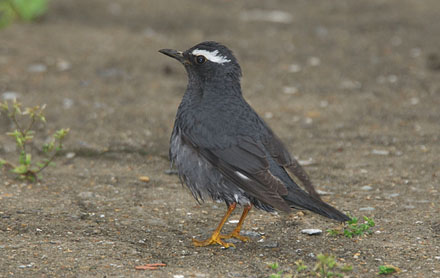
Grey Thrush Turdus cardis
A rare but annual spring migrant, mostly recorded on western islands and near to the south coast.
One male photographed on April 18th at Seolleung tombs (RN) is probably the first Seoul record.
Dark-throated Thrush Turdus ruficollis/atrogularis
A very scarce migrant and winter visitor, formerly considered conspecific with Red-throated thrush T.ruficollis, and still often called “Dark-throated Thrush”.
In 2007, a First-winter Black-throated x Red-throated Thrush hybrid was seen at Cheorwon on January 16th (NM, AW, BIH, PJ, KC, ME, MF), with another First-winter at Seosan on February 4th (RN, KHT): a further one or two were on Weiyon island on March 31st (NM, JYG, GS).
Black-throated Thrush Turdus atrogularis
One was on Eocheong Island on April 28th (GS, SSMP team) and an adult male was on Socheong Island on October 13th (TE).
Red-throated Thrush Turdus rufficollis
A scarce migrant and rare winter visitor, with almost all records between October and March.
In 2007, one at Cheorwon on February 1st (NM, MK) was followed by another at Seosan from February 3rd (NM, GR, NK, HJ, HM, CJ), seen repeatedly until at least March 4th (SKS). There was one on Hong Island on April 21st (BGJ) and a First-winter photographed on Eocheong Island on October 1st (NM).
Chinese Thrush Turdus mupinensis
One photographed and banded on May 14th on Hong Island (KSH) is the third record for Korea. Both previous records, on May 31st, 2003 and May 18th, 2005, are from Socheong Island.
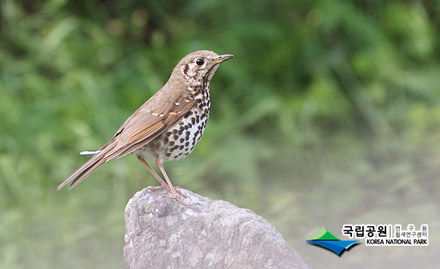
Photo © National Parks Migratory Bird Centre, Hong Island
Japanese Robin Erithacus akahige
A scarce and very skulking migrant, found mostly in spring (when in song), with only one autumn record (in November, 2004).
In 2007 two records away from the south and south-west involved at least one on Beka Island between April 28th and May 1st (SHS), and another heard in song on Socheong Island on May 12th (NM).
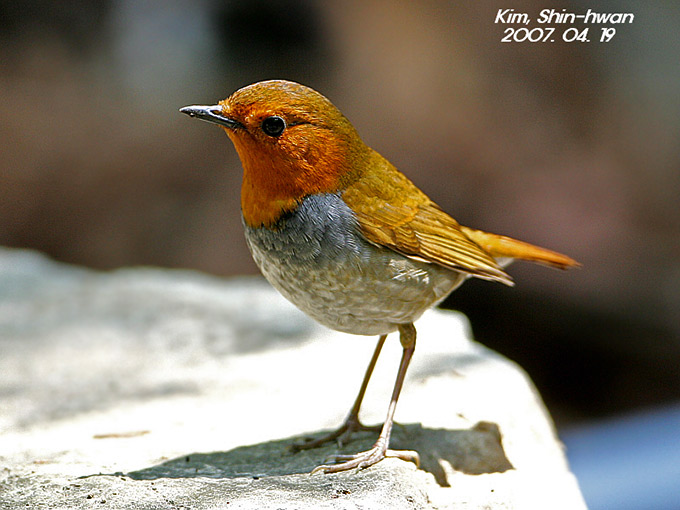
Black Redstart Phoenicurus ochruros
A rare spring overshooting migrant, recorded annually since 1999.
In 2007 a probable female on April 26th (RN) on Eocheong Island was eclipsed there by a male on April 28th (KHT) which remained until at least May 4th (RN).
Plumbeous Water Redstart Rhyacornis fuliginosus
First recorded in January 2006.
2007 began with a single female found at Seogwipo, Jeju Island in early January, which remained until February 4th at least (SKS): the fifth individual recorded in the ROK. Throughout 2007, a male and female, first found in territory at the "South-East River", Gyeonsangnam Province, on December 27th 2006, were observed (almost) each visit to the site. On February 27th, the male was watched repeatedly carrying food to a nest hole. Despite other typical breeding-type behavior observed through the summer, no young were observed. The female preferred feeding on a busy road in the mid-summer, and mortality of young due to heavy car traffic at the site might be a possibility. The male remained highly vocal and in territory towards the end of the year.
Siberian Stonechat Saxicola maura
One or two at Hadori, Jeju Island on February 6th (NM, GR, NK, HJ, HM, CJ) constitutes perhaps the first midwinter record.
White-throated Rock Thrush Monticola gularis
A very scarce passage migrant.
In 2007 notable day-counts came from Socheong Island, where six were noted on May 19th (NM, KK, HK, TL, JL, STZ, JRK), five on May 20th, and two on May 21st (TE).
Red-breasted Flycatcher Ficedula parva
One First-winter at Kangnam, Seoul on February 7th (JSS) was well-watched and photographed until at least February 16th (TE). Although there are four or five previous national records (following the first on Eocheong Island on April 30, 2003), this is the first mainland record, and the first record in mid-winter. This was followed by one photographed at Olympic Park, Seoul on November 18th (NGS) - the second mainland record.

Russett Sparrow Passer rutilans
At least one apparent hybrid Russet x Tree Sparrow P. montanus (site unknown) was photographed (SHS) on June 22nd and posted to the KWBS website: the first such record known to Birds Korea.
Eastern Yellow Wagtail Motacilla tschutschensis
One at Hadori, Jeju Island on February 6th (NM, GR, NK, HJ, HM, CJ) appears to be the first record of over-wintering known to Birds Korea.
Citrine Wagtail Motacilla citreola
A now annual migrant to offshore islands, most often recorded in April and May.
An inland record of one at Pocheon on April 27th (LSI) is exceptional.
White Wagtail Motacilla alba
Although regular in winter in the southeast, a leucopsis on the Han River, Seoul on February 2nd (NM, GR, NK, HJ, HM, CJ) is notable.
Rosy Pipit Anthus roseatus
One photographed on May 30th at Hong Island (BGJ, KSH) is approximately the seventh national record.

Photo © National Parks Migratory Bird Centre, Hong Island
Red-throated Pipit Anthus cervinus
One at Suncheon Bay on January 12th (NM, AW, BIH, PJ, KC, ME, MF) is perhaps the first mid-winter record of this species in Korea.
Water Pipit Anthus spinoletta
One at Hadori, Jeju Island on February 6th (NM,GR,NK,HJ,HM,CJ) was followed by another photographed on Weiyon Island on April 1st (NM,JYG,GS), the latter only the second spring record. There are now probably about ten recent winter records, including perhaps several at Misari in Seoul (via SKS).
Tristram's Bunting Emberiza tristrami
Following the recent trend towards over-wintering, up to 10 were at a site in Jeju on February 7th (NM, GR, NK, HJ, HM, CJ), with another also noted there on March 11th (NM, MK).
Yellow-breasted Bunting Emberiza aureola VULNERABLE
An apparently rapidly declining migrant.
At least 21 on May 11th at Eocheong Island (TE) and a flock of 50 on Socheong Island on May 19th (NM) are the highest known day-counts of the year.
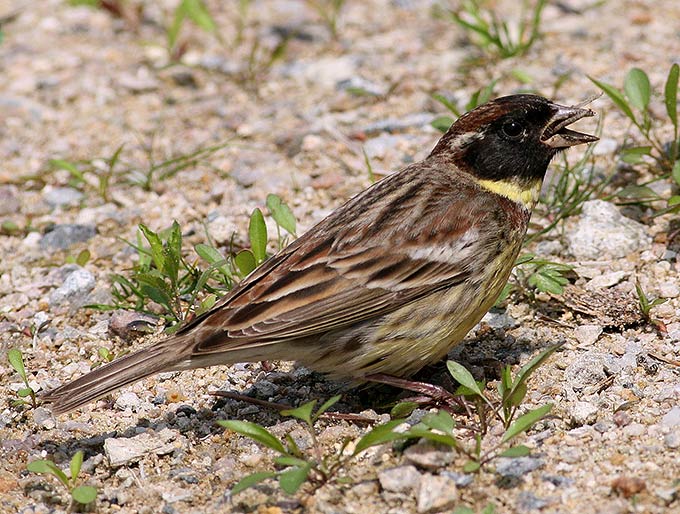
Black-headed Bunting Emberiza melanocephala
On Eocheong Island, a male was found on April 28th (KJH), with likely the same individual still present there on May 5th (RN). A female was found on May 12th (TE, GS). With only six records through to the end of 2005, these are possibly only the seventh and eighth records for Korea, all but two of which have been on Eocheong Island.
Red-headed Bunting Emberiza bruniceps
One or possibly two males were photographed on Hong Island between May 13th and 15th (LYM, SHS). There have been only three or four previous records.
Yellow Bunting Emberiza sulphurata VULNERABLE
A scarce spring migrant, mostly in the southwest and along the south coast.
One at Beka Island from April 28th to May 1st (SHS) represents a new site for this species.
Grey Bunting Emberiza variabilis
A scarce and easily-overlooked migrant and winter visitor, most regular in the southern provinces.
In 2007, there were perhaps 10 at a site on Jeju Island on February 7th (NM, GR, NK, HJ, HM, CJ). One was on Eocheong Island on April 25th (RN), until at least April 29th (GS, SSMP).
Snow Bunting Plectrophenax nivalis
One at Seosan (present since 18th December 2006) was observed until at least February 20th (KHK). This was followed by another, again at Seosan, on December 29th (RL).There are less than 10 records of this species in Korea.
Globally-threatened Species Recorded in 2007, and not Listed Above
The following globally-threatened species (i.e. Critically Endangered, Endangered or Vulnerable) were also recorded in 2007 at usual sites and in usual numbers.
Chinese Egret Egretta eulophotes
White-naped Crane Grus vipio
Red-crowned Crane Grus japonensis
Styan’s Grasshopper Warbler Locustella pleskei
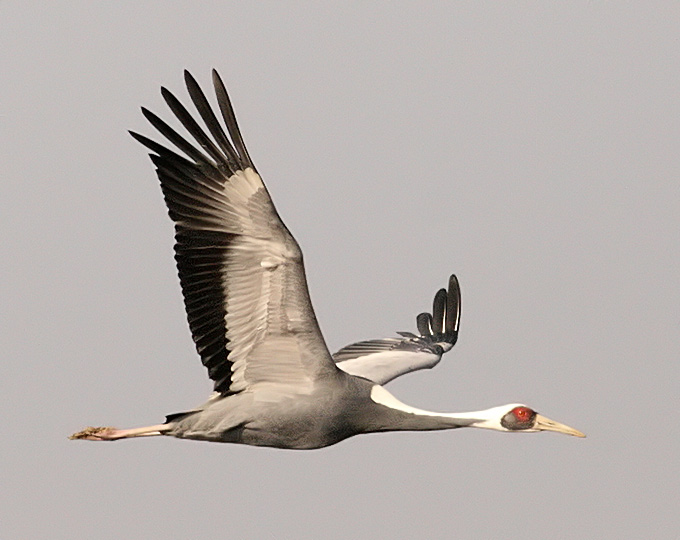

Further For the Record…
Exceptional records that are considered inadequately supported by images or that remain only tentatively identified at present are included here for future reference.
Steppe Buzzard Buteo buteo vulpinus
One presumed “Steppe Buzzard” (showing multiple features considered to be out of the range of “Eastern Buzzard” B.b.japonicu by NM) was photographed at medium-range on February 12th at Seosan (NM, GR, NK, HJ, HM, CJ)..
Semipalmated Plover Charadrius semipalmatus
One was seen poorly twice and heard clearly calling in flight by NM on May 16th, Yeongjong Island, Incheon, also being seen very briefly by KK, HK, TL, JL, STZ and JRK. There are no previous claims of the species in Korea (though at least two records in neighboring Japan).
Crested Murrelet Synthliboramphus wumizusume VULNERABLE
A rarely recorded species, although considered to breed in the far southwest (where no recent confirmed records).
In 2007, several possible sightings of flying birds were made between Yeon Do and Eocheong Island, Gunsan: one on April 9th (NM, TC, AP); two on April 21st (NM, GS, ES, CSH, KHK); four on April 27th (RN); and finally one on June 3rd (NM).
Elegant Scops Owl Otus elegans
An owl taken into care on Jeju Island on February 6th after being attacked by a cat, was considered to be possibly of this species by finders. Tentative identification was based largely on the mewing-like vocalisations the bird gave. While this begging call proved a good match Elegant Scops Owl, the diagnostic territorial call was not heard. If confirmed this would be the first record of this species in Korea.
Grey-chinned Minivet Pericrotus solaris / Long-tailed Minivet Pericrocotus ethologus
A female minivet with strong wingbars and yellow underparts was seen in overhead flight on May 20th at Socheong Island (NM, KK, HK, STZ).
Chinese Leaf Warbler Phylloscopus yunnanensis
On Socheong Island, one probable was seen on May 19th, and the following day another (presumed) individual was heard (NM). There is only one record accepted by Birds Korea for the ROK of this Category 3 species (one on Socheong Island on October 16th 2004: Moores, 2007), although birds are now claimed annually.
Acknowledgements
Birds Korea would like to thank all contributors, and especially Dr Shim Kyu-Sik (President of the KWBS and Birds Korea Life member) for his assistance with checking the details of numerous records. Further thanks also to Andreas Bucheim, Dr. Igor Fefelov, Andrew Grieve, David James, Peter Kennerly, Richard Klim, Dr. Rich Reading, and David Sargeant for comments on particular records and taxonomy, and funders of the Saemangeum Shorebird Monitoring Program and other research work (most especially, The David and Lucile Packard Foundation, Phil Hansbro and Newcastle University, Australia, and the Queensland Wader Studies Group).
References
- Anon., 2008. Natural Heritage and Folklore of Jeju Island. Published by the Folklore and Natural History Museum. (In English).
- Austin, O. 1948. The birds of Korea. Bulletin of the Museum of Comparative Zoology, Harvard University 101: 1-301.
- Brazil, M. 1991. The birds of Japan. London: Christopher Helm.
- Duckworth, J. 2004. Eight Birds New to DPR Korea. Forktail 20: 116-120.
- Duckworth, J. W. and Kim Chol. 2005. Scaly-sided Mergansers Mergus squamatus on the lower Chongchon River, central Korea. Wildfowl 55: 133-141.
- Gore, M. & Won P-O. 1971. Birds of Korea. Seoul: Royal Asiatic Society.
- Lee, H., Lee, S.-W., Lee, K.-S. and Paek, W.-K. (2004) The wintering status of Cinereous Vultures (Aegypius monachus) in Korea. P. 237 in S.-J. Rhim, J.-S. Kim, O.-K. Chung and S.-J. Park, eds. Proc. 2004 Intern. Symp. Migratory Birds, Gunsan. Seoul: Korean Ornithological Society.
- Lee W-S, Koo T-H & J-Y Park. 2000. A Field Guide to The Birds of Korea. LG Evergreen Foundation.
- Moores, N. 2002. Wetlands: Korea's most-threatened habitat. Oriental Bird Club Bulletin 36: 54-60.
- Moores, N. 2006. South Korea’s Shorebirds: A Review of Abundance, Distribution,
Threats and Conservation Status. Stilt 50: 62-72. Published by the Australasian Wader Studies Group. - Moores, N. 2007. Selected Records from Socheong Island, South Korea. Forktail 23: 102–124
- Moores, N., D. Rogers, Koh C-H., Ju Y-K, Kim R-H and Park M-N. 2007. The 2007 Saemangeum Shorebird Monitoring Program Report. Published by Birds Korea, Busan.
- Park J-Y. 2002. Current status and distribution of birds in Korea. Seoul: Department of Biology, Kyung Hee University (unpublished thesis). (In Korean)
- Prentice, D. S. 1952. Bird observations in Korea. The Passenger Pigeon 14(4): 137-141.
- Reeves, A., Drovetski S. & I. Fadeev 2008. Mitochondrial DNA data imply a stepping-stone colonization of Beringia by arctic warbler Phylloscopus borealis. J Avian Biol 39(5).
- Saitoh T., Nishiumi I., Alström P., Olsson U. & K. Ueda K. 2006. Deep phylogeographical divergences among Far Eastern populations of the widespread Arctic Warbler. Abstract in the
- Proceedings of the 24th International Ornithological Congress, Hamburg, Germany, 13-19 August 2006.
- Seo J-H & Park J-G. 2008. A Photographic Guide to the Birds of Korea. Published by Shingu Munhwasa (in Korean).
- Tomek, T. 1999-2002. The birds of North Korea. Acta Zoologica Cracoviensia 42: 1-217; 45: 1-235.
- Wetlands International. 2006. Waterbird Population Estimates – Fourth Edition. Wetlands International, Wageningen, The Netherlands.
- Wolfe, L. R. 1950. Notes on the birds of Korea. Auk 67: 433-455.
Further Online Resources





